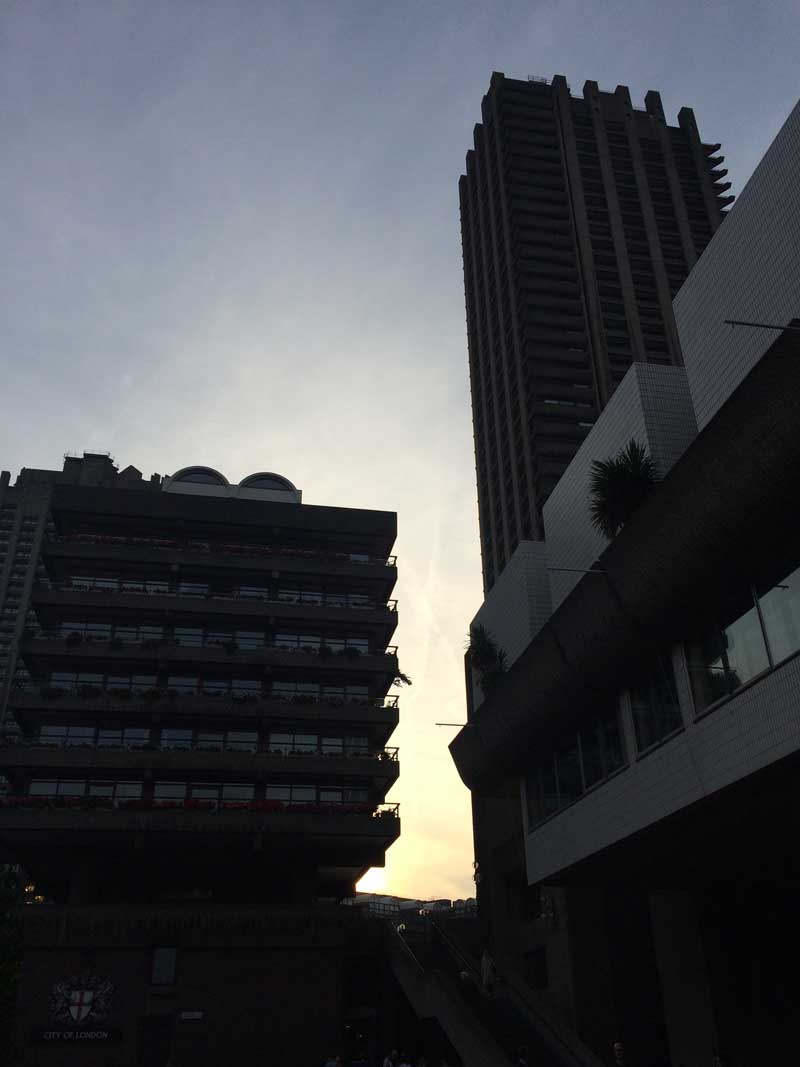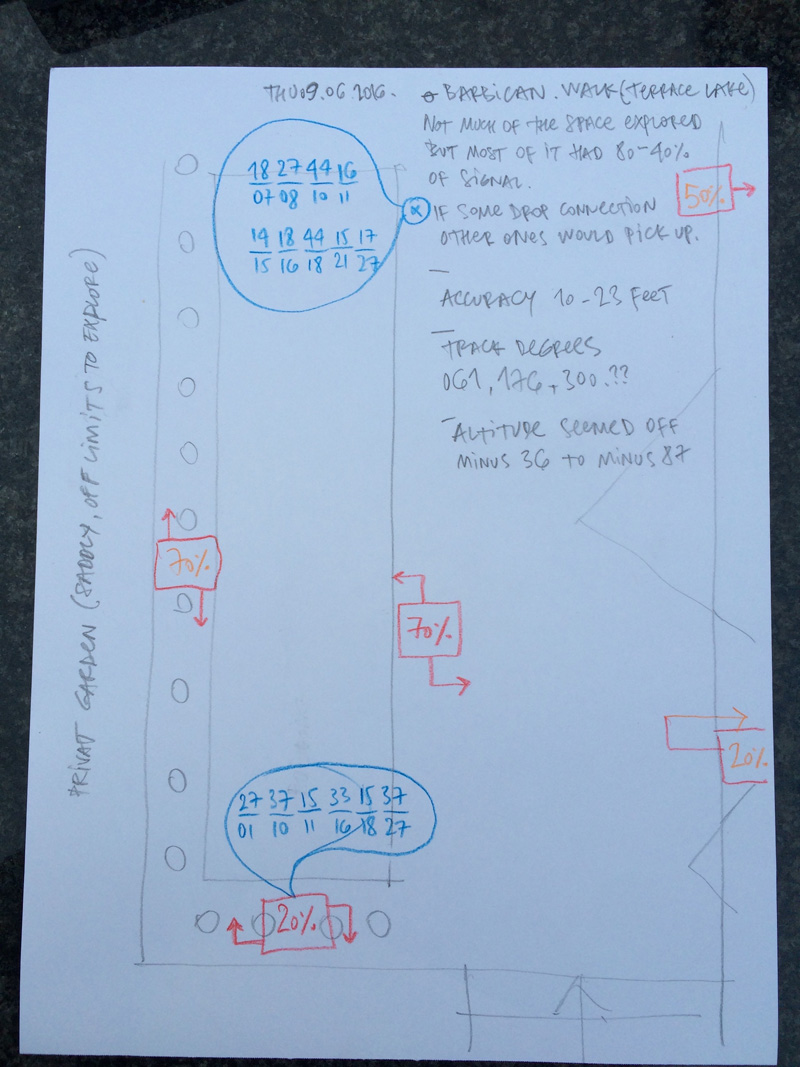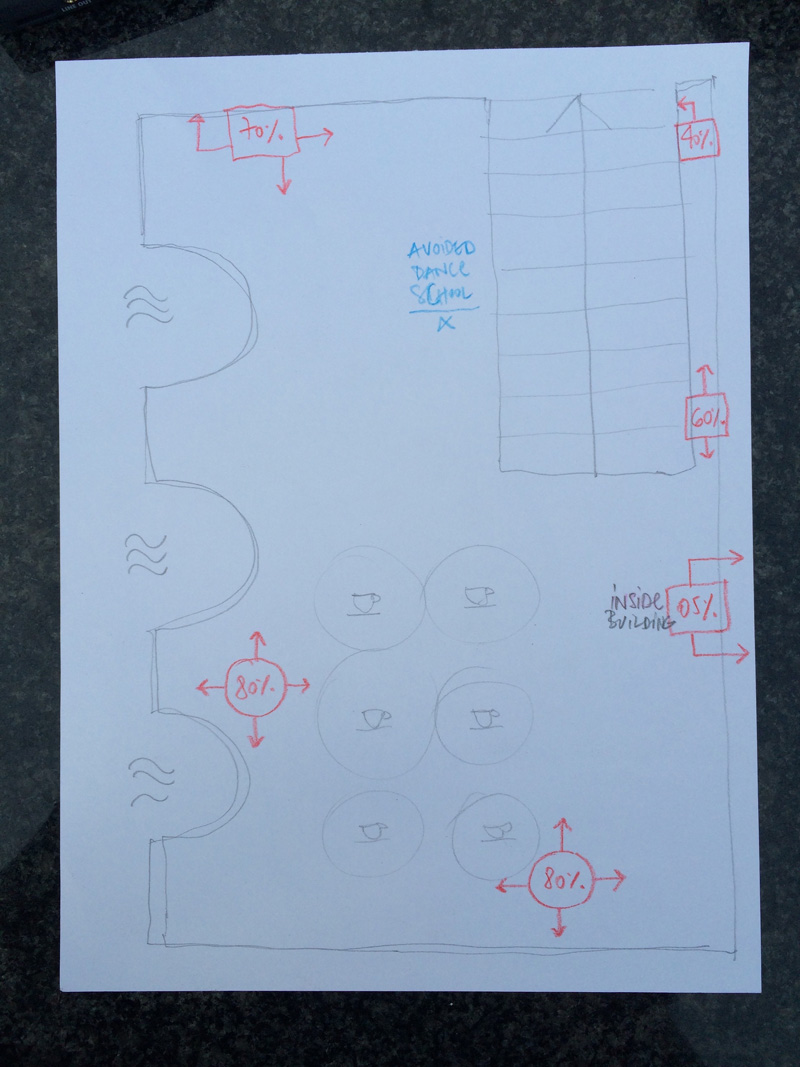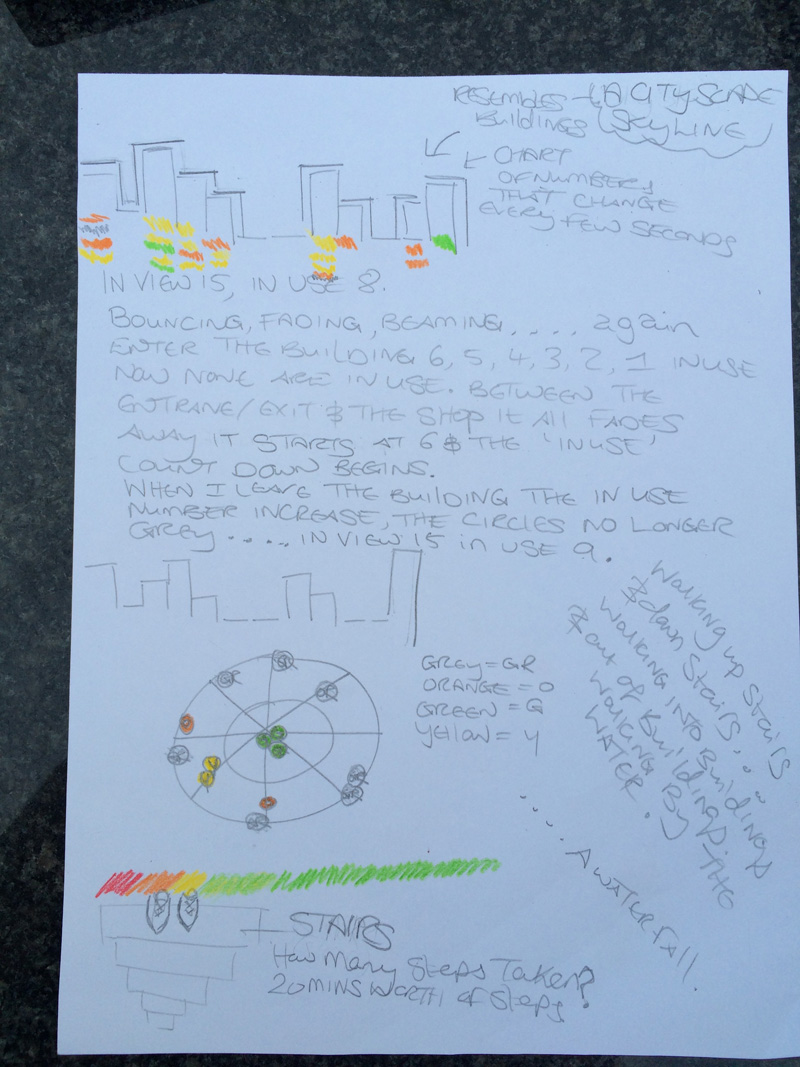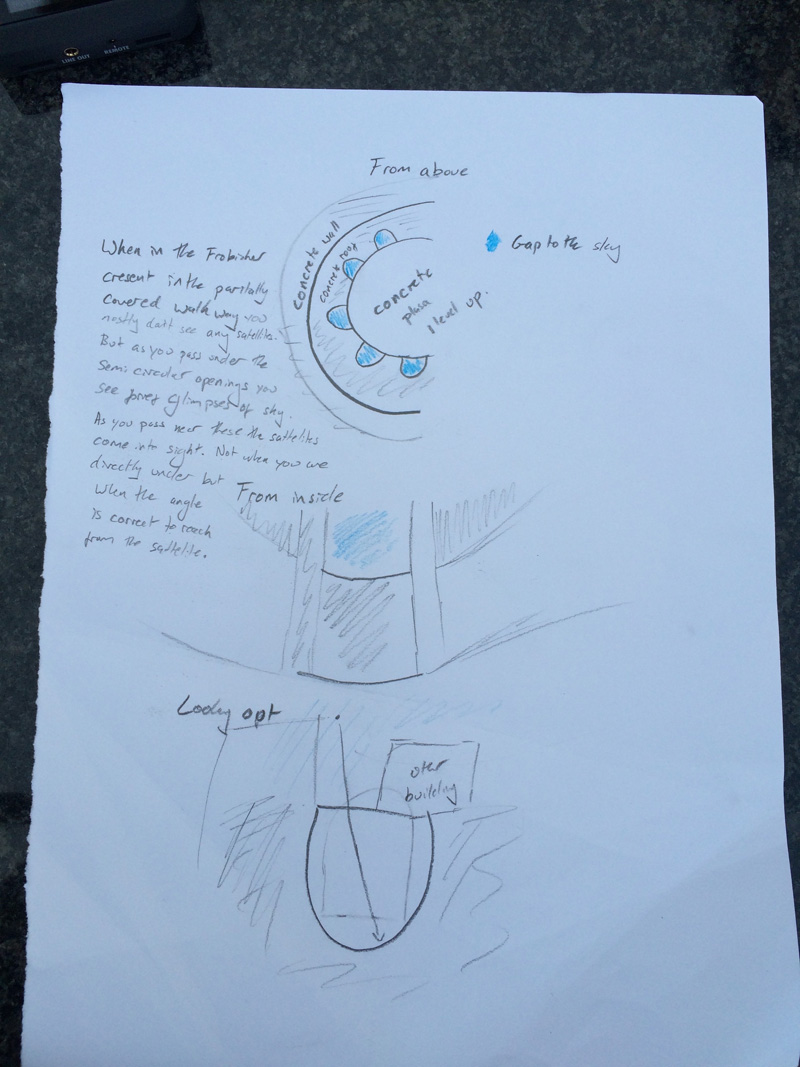June 9th 2016
In a workshop organised in association with antiuniversity participants explored the Barbican Estate in London using a GPS-diagnostic app called GPS Test. The intention of the workshop was to raise critical reflection about the infrastructures which lie behind the sense of location given by GNSS (Global Navigation Satellite Systems) infrastructures. After a brief explanatory introduction, participants walked freely around the estate for 20 minutes, observing how the architecture of the estate interrupted the functionality of their phones' GNSS sensors. They then spent some time doing drawing and writing reflecting on the experience. This was followed by a 20 minute discussion.
The images drawn by participants and a transcript of the discussion are offered here in the spirit of antiuniversity, against the blackboxing of research within instituational boundaries. The contents of this page are free for all to use under Creative Commons' Attribution-ShareAlike license. Workshop organised by Christopher Wood (C in below transcript).
TRANSCRIPT
C: do u wanna say something?
D: I think initially for me, interestingly enough, its probably in part die to the fact you said sound had a material impact on the way we look at things, i noticed as soon as i sat down, the sound of water, which is something that I came back to. And, I’m not sure how it related to my experience of walking around or really how it effected what my sensor sent to the satellite, but it was certainly part of my experience. funnily enough, when i went back to the water, that was when I got the strongest signal, I think architecture is the reason why that’s the case. I think initially, reminding that this is sending a signal to a satellite [untrue], had me very aware of elevation and height and I had a compulsion to actually try and get higher to see what would happen, that was the idea, but interestingly enough actually what I did was go to the car park. Which is straight through there and it’s basically a dead zone, which I found really interesting, but a daed zone for this particular type of signal. So there were parts of that space where the satellite signal was void, but my ur, data signal was fine. So it was very interesting to wonder, what was it a part of that underground building that made it ok for the data signal, but not for the GPS signal. And I found that really really interesting.
O: It’s interesting, oh sorry, its just interesting you said about elevation because its interesting that most of us, if not all of us ended up going up those stairs and going up to that area up there and I was wondering, was that in an effort to lose signal or gain signal, like what was your main motivation? were you going to reduce the number of satellites that you could fins or were you going to boost it and get it to 32 or…
D: For me it was, the intention was to see if I would get a stronger signal because it was after going into the dead zone of the car park so for me the intention was: oh wow I have nothing down here, but i wonder what happens when I go up, when I get higher. There was a compulsion to actually see what happens. um, what else before I forget… I think for me there’s something about reminding just how complex a device I was holding, which is something I don’t normally consider in my day-to-day action, thinking how architecture and buildings, obviously at the time this was built, built with like, signals in mind, and I was wondering to what extent they are built now with the realisation that actually these signals are sort of critical to many peoples’ lives and to what extent are dead zones avoided or at least for these spaces, does GPS, telephone signal matter? um what else, du du duh, I mentioned that… I think for me as well I named this [drawing] as walking into signals because for me I think I was reminded that I’m hitting all these various things that are floating around between various devices and the experience for me was me trying to navigate all of that as part of me trying to figure out what GPS is and how this device is linked
O: For me its more like different densities of signal so you’ve got like universal background static all the way down to these super-precise signals and very short range signals which are probably coming from like wifi routers in the building or peoples’ phones and its this whole nested scale of like different kinds of signal which are penetrating your body, your phone, the building around you, and you’re also part of that structure in a way, you know, you’re accepting, receiving, deflecting all this stuff as well. And for me as well, the stuff I was thinking about as I was walking around was that in a sense what e’ve actually done by consciously trying to find signals is that we’ve inverted the relationship between ourselves and the GPS. Whereas usually we use GPS to find us and we use it to position ourselves and you know, how close am I to the cinema, how close am I to my uber taxi, and actually what we’re doing is inverting it and using it to try and find the GPS signals, and its like a complete inversion of the normal relationship you have with this stuff as we’re thinking about and that also effects your relationship with space and architecture. I mean everyone round here is using space in a kind of architectural way, maybe without being aware of it. They’re going from point A which is coming out to have a coffee outside - they want to use the exit and they’ll move through the building in a way which is kind of, the architects have planned for them to use the space, whereas we are using it in a completely different way, which goes against that, which is why we kind of stood out a little bit by being the ones, you know, when we were standing up there, the only people walking through were walking very purposely, going home, going to work, going out in these straight lines across space, whereas we were weaving all over the place and standing in weird corners and kind of looking at our phones and kind of trying to wedge ourselves in spaces where you weren’t kind of, you know looking at different peoples’, and we looked so different, the way we were using that space and that’s what I found interesting.
I: yeah, I guess I come from a completely different background of using this. I’ve never actually thought about GPS apart from I want to know where I am, click on my phone and it finds me. And first time I got introduced to this really tiny space and it’s bouncing the signal was like Croatia and Italy, like those really dalmatian old towns or venice or whatever town has really narrow streets it really messes up the signal which i was trying to kind of find the corners where the signal might get messed up in some sort of way, the only thing is this doesn’t really, i mean it tells you the accuracy between 23ft, that’s what i was kind of looking at to try and track the accuracy, because that was the most interesting part for me. because I would usually play that game, where am I in relation to GPS, if GPS can find me so I kind of play hide and seek with this, so that’s what I’ve been doing. But the first thing that I wanted to do was go down to the garden which was apparently is a private garden so I cannot go there [laughter] so I cannot go there, so let’s kind of go around where I can walk around and then was um walking behind, um any kind of area that had a lot of structures so it’s not open space, even if you go out to the open space, it’s still like 80% coverage. so it’s between 80% and 20% of coverage unless you really go inside. and then its almost nothing, for some weird reason, but here at the doors like what you were saying with the routers. I know the router like if this [phone] would be connected to the routers then it would detect, right?
C: The devices I gave you had the wifi turned off on them, but that shouldn’t make a difference because the GPS diagnostic app is expressly to look for GPS, but usually your location, if you’ve got your wifi on, is determined by that as well.
I: So that’s pretty much it, so like ‘track degrees’ i’m not sure what that is, but its going kind of mad, with um the numbers. I’m not a numbers person so this was kind of interesting to be like, ok, what do these numbers tell me. I was taking pictures with the phone in certain spaces and tracking which satellites can be seen and which not, so yeah, you get the paper. [laughs] so I think that’s pretty much what it is.
N: Um yeah, I was just curious just yeah going up and down the stairs and into buildings and stuff and noticing like the dead zones and the numbers quickly dropping and i dunno, its all quite new to me to be honest, I think it was interesting what you were saying about the buildings and whether they’re compatible with the signals and will they be in the future and its worth exploring, maybe each sort of area it might be different. Because the buildings were made by like different groups of people, different architects, different materials, so it might be worth doing to test again in some other places, something like that and look at the results.
L: I was quite interested in yeah the line of sight and what buildings were where and even when you’re under something and you think you shouldn’t get any satellites, you still have three or four quite often. The most interesting bit for me was I was walking under, I think it’s the Frobisher Crescent? Just the crescent walkway kind of one level down from the plaza. And its mostly kind of covered so you don’t get any signal, but there are these kind of semi-circular entrance ways and in there if you stand in certain places you get 1 or 2 satellites coming down and I was kind of thinking about that and thinking about could you do something whereby if you had a really accurate one of these [phone] could you work out what kind of building you were in, almost map it using the signals coming down and coming through and using it to do that.
C: On a previous walk someone suggested making some kind of topography, a topological map of where signal is hidden and where its available.
L: Yeah, exactly and using that to work backwards to see what’s causing that almost. Cos if you know where all the satellites are then you can work backwards.
C: It’s a really crazy idea cos it will be different to every time of the day depending on where the satellites are:
L: yeah, exactly [laughs]
S: Not much [holds up paper, laughter]. It was definitely an interesting experience to see how many satellites are there and how these devices which we are using daily actually work and… not much… I had um, I was thinking about how actually everyone is trackable and how that opens a way for anyone to really like control you and um.
C: I’m glad you said that, I was waiting for someone to say that. It was a strong theme in the other workshops
S: Also with the signals, there are so many signals int he air that we don’t hear with our ears but we feel them and like so many of those kinds of stuff
O: [to D] I thought it was interesting actually what you said about whether architects build for
D: I thought you might have something to say about that
O: I mean if you look over there, that’s how cities get build now, hyper densification
D: Yes, Yes
O: And we rely on signals more and more and its completely incongruent with how we want to use, like everyone has a smartphone pretty much and, if that’s how we build cities - super-dense - then that’s completely ill-suited to how we actually use this technology
C: when you said that I got the notebook out straight away cos I was thinking that this type of architecture, like glass and steel, lots and lots of windows, so GPS that’s actually a super visible way cos you’re more likely to get signals through the windows
O: but cladding would be an issue
C: yeah, yeah, but definitely from my experience, when you’re inside, next to a window, you get more purchase. So if your whole building’s a window…
L: yeah, I got quite a lot of signal when I was coming down that staircase cos that’s quite open
C: so themes that emerged from some of the previous workshops were: surveillance, who’s watching us, for what purpose are they watching us? but there’s a flip side to that which is that some people who have done the walks have a real urge to become visible to the satellites, they wanna get those numbers up, get as many in view as possible
I: Can I just say that I tried to hide and I realised that there’s pretty much nowhere to hide unless you get inside or…
D: One thing I was wondering about was one thing that was very unclear to me was that because I was thinking about the signals visually, almost like a cartoon so I wrote it here: ‘the signals are flying around’ so I did this kind of going up the stairs, this kind of half circle through the space and in the back end there are two columns, and there’s a space in the middle and I was propelled to stand right at that back, with the two columns right above me and I was trying to imagine in terms of trying to visualise all of the signals, like what do they look like, I mean I found that really interesting for me, as someone who’s slightly visual and also tends to see things like cartoons, are they bouncing off the walls, i mean what does this look like if I could visualise like what’s happening so I was standing there thinking, are the signals getting stronger cos it’s hitting this wall, bouncing there, that’s what this bit is and its like finally getting released from this two column space and then going freely into the air.
O: It’s kind of interesting I mean to you think about them as lines or as a diffuse field, or as a block, or as a colour, do you attach colour to it, I mean I don;t know.
C: an interesting side question with that is how deterministic the interface is cos you’re looking at like these circles or triangles plotted on a circle so I’m going to be interested to see how much that influenced what you draw. it’s definitely been something that’s popped up in the past. But then that opens up questions like how would you design an interface that would visualise these things a different way?
I: that’s very interesting, I mean on my side cos I really like to draw stuff and I was kind of blocked cos I’m usually seeing graphs like this, that way so it doesn’t really excite me that much to see the way that it’s done, but then I don’t have any special idea like how I would design it better
S: and also the latency from the satellite is kind of irregular. It’s just something we cope with every day, just having these slow responses from um the satellite.
I: maybe what… like slightly different colours like fill out the screen, like only make it visual in the sense of how many like 30 satellites, so then you slice the screen in 30 parts and then the brighter that part is that’s how you can kind of see that satellite, so you don’t have any numbers as such, but if the whole screen lights up then that means you’re pretty much visible to all the satellites, maybe that would be one of the ways to present it but in a different way, but that’s just a different way to what you have cos it’s these graphs and up and down
L: I think I’d like to see the possible locations each satellite thinks you could be in - cos each satellite shows how far you are away from it and nothing else, every satellite is a sphere of locations and the intersections of those is where you are and kind of seeing that as a map or something would be really interesting.
I: but isn’t that that circular one?
L: It’s the other way round
I: hmm?
L: It’s the reverse
I: It’s the reverse, OK
C: What’s interesting for me also is this tension between maps as a static object and maps as a dynamic object, because what we’re looking at changes temporally as the satellites move around. So that can be rendered as a static map , but is it the same experience? what happens in that translation, when you stop everything. Especially when, as a communications system, the whole thing is based on time. OK that’s great. Does anyone have anything to add?
D: The only thing I was going to add was that for me, the experience of reminding myself of the relationship between device and satellite had the same impact as when i’m in a space where I can see the stars. I often forget that I’m on a planet, I know it sounds… I often forget that I’m on a planet, one of many in a much bigger space, and whenever I see the stars it has an impact of right! right! and that’s circling, right! so for me its a slightly humbling experience because as I sometimes tend to do, I become focussed on my own very narrow, individualistic life and the next, I don’t know 40, 50 years that I have and this experience has just reminded me of this scope of things, the ecosystem that is my life, the universe, it’s like oh right, its that, oh right, right over there, ok, and that came off very powerfully when I sat down and started to look up
O: I was going to say, we all instinctively keep looking up, at what exactly
C: Yeah, you can’t, the phone can see it, but you
D: Yeah, exactly - oh 34, OK
C: yeah, exactly. All of those numbers are unique identifying numbers for each satellite, so that should be consistent across devices, ur, yeah. I think that metaphor, I mean, part of the thing that really made me fall in love with this project was when I found out that the term for a group of satellites was a constellation,
O: yeah, it’s perfect really
C: Yeah, like you know, we’ve got all these constellations up there that we’ve got all these stories about, but we don’t have any stories for these new things that have been put up there in the past 20 years
D: man-made ones at that
